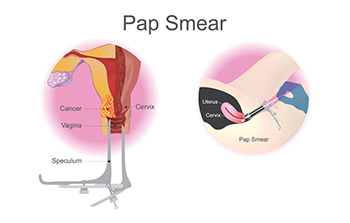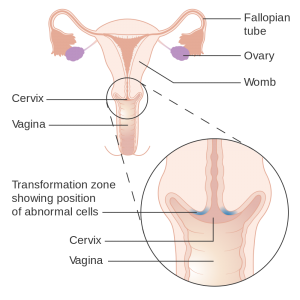Cervical screening (a smear test) checks the health of your cervix. The cervix is the opening to your womb at the top of your vagina. Pap smears detect changes in the cells of the cervix before they become cancerous. All sexually active women aged 25 to 64 should have regular pap smear examinations. During the screening appointment, a small sample of cells will be taken from your cervix using a tine brush and spatula. The sample is tested for changes in the cells of your cervix caused by HPV, the virus which causes cervical cancer. Finding abnormal changes early means they can be monitored or treated so they do not get a chance to progress to cervical cancer.
changes in the cells of the cervix before they become cancerous. All sexually active women aged 25 to 64 should have regular pap smear examinations. During the screening appointment, a small sample of cells will be taken from your cervix using a tine brush and spatula. The sample is tested for changes in the cells of your cervix caused by HPV, the virus which causes cervical cancer. Finding abnormal changes early means they can be monitored or treated so they do not get a chance to progress to cervical cancer.
The result should be ready in 3 weeks and you will be contacted by phone.
My Results Are Abnormal, Should I Be Worried?
While it is understandable that you might be worried if you receive an abnormal smear result, it is important to bear in mind that 1 in 20 cervical screens come back with some form of abnormality. It is also natural to be concerned as to the severity of the cervical changes and what implications this may have on your health. However, an abnormal result in most cases does not mean you have cancer. It simply means that there are changes to the cells which could potentially cause cancer in the future. This is why cervical screenings help to save lives!

Coronal section of female reproductive anatomy
Original Exit Writer image
Referenced from KDAL # 4A1123
Abnormalities in cervical cells are caused by an infection with the Human Papilloma Virus (HPV). This is otherwise known as the Wart Virus. It is estimated that as many as 75% of the reproductive-age population has been infected with one or more types of genital HPV. The good news is that in the vast majority of cases (approximately 95%), the HPV virus causes no symptoms or health problems. Most women will fight the infection via their immune system, but for others, it can progress and result in abnormal cells (dyskaryosis).
There are more than 100 different types of HPV and about 40 strains affect the genital areas and can be easily passed on through sexual contact. Several of these are linked to cervical cancer, which is why they are medically referred to as high-risk HPV strains. Of these, types 16 and 18 are the most common, causing 70% of cervical cancers.
Abnormal Smear Result Grades
An abnormal smear can be categorised as mild, moderate or severe dyskaryosis. The abnormal cells which can be found on the surface area of the cervix are called Cervical Intra-epithelial Neoplasia (CIN) and there are three different CIN categories based on the degree of cellular abnormalities detected.
- CIN 1 means mild or low grade dyskaryosis
- CIN 2 means moderate dyskaryosis
- CIN 3 means severe or high grade dyskaryosis
If you have a low grade dyskaryosis result (mild and borderline), then you will typically be advised to have an additional smear test in 6 months or a colposcopy to clarify the initial results. Testing for high risk HPV types may reduce the need to have colposcopy or frequent repeat pap smears if your result shows borderline or mild changes.
At colposcopy the cervix is visualised using a speculum and is examined under magnification for evidence of low or high-grade changes. Two dyes are then applied to the cervix (acetic acid and iodine) to help highlight any abnormalities present. If the changes are confirmed to be mild in nature, then a conservative approach will be recommended as it is likely that the affected cells will go back to normal without the need for treatment. Abnormal areas would be biopsied or excised.
High Grade Dyskaryosis
 Where a smear test comes back with a high grade dyskaryosis result, you will be referred to colposcopy by your gynaecologist. This will establish the true extent of the affected cells. Those with high-grade dyskaryosis results often need treatment, which aims to remove the abnormal cervical cells. At colposcopy a portion of the cervix may be removed under local anaesthesia.
Where a smear test comes back with a high grade dyskaryosis result, you will be referred to colposcopy by your gynaecologist. This will establish the true extent of the affected cells. Those with high-grade dyskaryosis results often need treatment, which aims to remove the abnormal cervical cells. At colposcopy a portion of the cervix may be removed under local anaesthesia.
Cervical cancer is an avoidable condition, you should always follow the advice of your doctor or gynaecologist and undergo regular screenings to monitor cervical changes, while promptly addressing any problems by attending follow-up requests and undergoing treatment where necessary to ensure that your cervix is healthy and unaffected by any pre-cancerous cells.Cervical screenings save lives!
HPV vaccine prevents infection with human papillomavirus (HPV) types that are associated with many cancers, including:
- cervical cancer in females,
- vaginal and vulvar cancers in females,
- anal cancer in females and males,
- throat cancer in females and males, and
- penile cancer in males,
In addition, HPV vaccine prevents infection with HPV types that cause genital warts in both females and males. In the U.S., about 12,000 women get cervical cancer every year, and about 4,000 women die from it. HPV vaccine can prevent most of these cases of cervical cancer.
Vaccination is not a substitute for cervical cancer screening. This vaccine does not protect against all HPV types that can cause cervical cancer. Women should still get regular Pap tests.
Vaccination Schedule
Routine vaccination is generally given around age 11-12,but can be given from age 9-14 where 2 doses 6-12 month apart can be given.
At age 15 and over, 3 doses at 0,2 & 6 months are required to reach the desired level of immunity.
The vaccine is normally given to females who have never been sexually active but may still be of benefit to sexually active woman, as they may not have been exposed to all strains of HPV covered by the vaccine.
Side Effects Common- soreness & redness at injection site. Fever.
Rare – severe allergic reaction 1 in 1million doses
